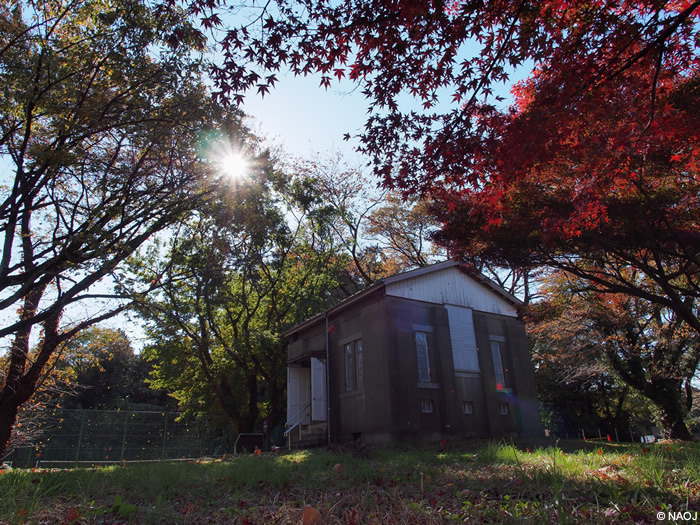Mitaka Autumn Scenery Dyed Chaotically
Photo・

| Date | Autumn 2012 |
|---|---|
| Location | NAOJ Mitaka Campus |
| Photographer | Yutaka Iijima |
| Credit | National Astronomical Observatory of Japan |
| Terms of Use | This image can be used without permission for research presentations, conferences, and school classes. In other cases, it cannot be used without prior permission. If you would like to use it, please fill out an application. In the case of commercial use, a photograph usage fee might need to be negotiated with the photographer, Mr. Yutaka Iijima. |
NAOJ Mitaka Campus, enclosed in trees, becomes dyed with vivid color schemes as autumn progressively deepens. This is a picture of the Repsold Transit Instrument housing taken one fair day. This facility previously conducted precise stellar position measurements. The Repsold Transit Instrument preserved in this building was the leading instrument for Japan’s first standardized observation star charts and has been registered as an important cultural property. The building which continues to protect this important milestone of astronomical history stands in this cool season with a quiet antique appearance.
The Transit Instrument which Supported the Dawn of Modern Japanese Astronomy
The Repsold Transit Instrument stored in this housing in the present Mitaka Campus is an 1880 German-made observational instrument. A transit instrument is a telescope which can point along the meridian (the line connecting North and South.) It is used for longitudinal surveys or time determination through precise measurements of the passage of celestial bodies. This transit instrument which supported the dawn of Japanese astronomy had been established in Azabu, Minato Ward during the era of the former Tokyo Astronomical Observatory. To this day, that location is the reference point for longitude and latitude in Japan.
The Repsold Transit Instrument was installed in the current housing when it was moved to Mitaka, and was used for positional surveys of numerous celestial objects. In 1949 those results were published in the “Tokyo Mitaka Catalogue of Zodiacal Stars*,” Japan’s first standardized observation star chart. Additional results were published in the “Tokyo Mitaka Catalogue of Equatorial Stars*” in 1962. Now, it is preserved and displayed along with other historical repsold transit instruments in the Repsold Transit Instrument housing which is open to the public. The structure is built in a fashion reminiscent of the Modern architectural style popular at the beginning of the 20th century; the decorations on the tops of the columns and the secession displayed on the eaves of the entrance use straight-line patterns.
Author: Seiichiro Naito (Public Relations Center, NAOJ)
(*Both appeared in the Annals of the Tokyo Astronomical Observatory Second Series)